Exploring the Impact of Dubai's Tram Stations on Urban Mobility
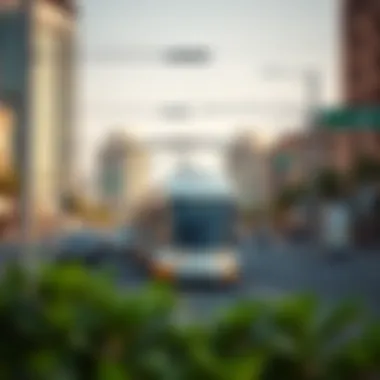

Intro
Dubai's tram stations are more than just transit points; they are a pivotal part of the urban landscape, affecting how people move and live in the city. As the city continues to grow and develop, the tram system has been hailed as an innovative solution to some of the challenges the metropolis faces, such as traffic congestion and pollution. This article will provide an in-depth examination of the tram stations in Dubai, considering not just their operational capabilities but also examining how they influence everything from the urban transportation network to real estate dynamics.
The tram network serves a dual purpose. Firstly, it aims to provide an efficient transport alternative that operates smoothly alongside existing modes of transport like the Metro and buses. Secondly, tram stations often become centers for real estate activity, driving investments and shaping the neighborhoods around them.
By exploring the façades of these stations, it becomes clear that they are designed not just for functionality but also for aesthetic appeal. As we delve into the nuances of each tram station, we will uncover the intricacies of metro life in a city renowned for its ambitious infrastructure projects.
Market Trends
In this fast-paced environment, understanding market trends is crucial. With the tram system to provide reliable connectivity, real estate prices have seen fluctuations that investors and homeowners need to note.
Current Real Estate Pricing
In neighborhoods surrounding tram stations, property values are on the rise. For instance, areas like Dubai Marina and Jumeirah Beach Residence are witnessing increased demand, partly due to their accessibility to tram stations. As commuters seek convenience, properties nearby become more desirable, thereby inflating prices.
- Luxury apartments along the tram route can command premium prices, but they're also welcoming burgeoning middle-class buyers.
- Average prices can vary from AED 1,500 to AED 2,500 per square foot depending on the area.
- Rental demand is substantial; properties can be rented for AED 70,000 to AED 150,000 annually in tram-adjacent districts.
Emerging Neighborhoods and Developments
As the tram infrastructure expands, new neighborhoods are popping up, adapting to this modern transit solution. Places like Al Sufouh and Dubai Science Park are evolving rapidly, with developers keen on capitalizing on the accessibility offered by tram stations.
- Al Sufouh is showing significant growth with modern villas and townhouses available for families looking to settle near transit options.
- New developments often come with smart technology integrations, aligning with Dubai's vision for a high-tech future.
"The tram’s reach shapes Dubai’s urban fabric, making it an attractive reality for investors seeking long-term gains."
Investment Opportunities
Investors looking toward the tram-connected regions can find varied opportunities, whether for rental or resale. Understanding the timing and nature of investment is essential.
Short-Term vs Long-Term Investment Strategies
- Short-Term: Focusing on property flippers can yield quick returns, especially in up-and-coming areas
- Long-Term: Holding properties in established neighborhoods tends to provide stability and ongoing rental income, especially as more people opt to live closer to their workplaces.
Financing and Mortgage Options
Here, various mortgage options help potential buyers navigate the real estate landscape:
- Conventional Mortgages: Often preferred by expats and local buyers alike, facilitating long-term ownership.
- Islamic Financing: A popular choice among local citizens offering Sharia-compliant financial products.
Prelude to Dubai's Tram System
The tram system in Dubai represents a significant stride in the evolution of urban transport within the city. Serving as a vital cog in the larger transportation wheel, it not only enhances mobility for residents and tourists alike, but it also plays a pivotal role in shaping the urban environment. This introduction delves into the essence of the Dubai tram system, shedding light on its historical roots, current functionality, and future potential against the thriving backdrop of one of the most dynamic cities globally.
Historical Context
Dubai’s foray into tram transportation can be traced back to the early 2000s, when urban planners sought to tackle the increasing congestion and pollution caused by a surge in automobile usage. The visionary decision to introduce tram trains aimed to provide an alternative, aiming to foster a cleaner and more efficient public transportation model. The Dubai Tram officially commenced operations in 2014, marking a significant milestone.
What’s interesting here is how this initiative reflects not just a response to immediate transport needs but also a commitment to sustainable urban planning. Cities typically attempt to retroactively address their transport infrastructure; however, Dubai integrated the tram lines purposefully from the ground up, ensuring they align seamlessly with broader urban developments, such as the Dubai Marina and Jumeirah Beach Residence. The tram was strategically designed to alleviate traffic pressure while encouraging public transport usage.
Current Network Overview
The current network of Dubai’s tram system comprises 11 stations stretching across approximately 14 kilometers. Each station is placed thoughtfully to connect crucial areas, catering to a variety of commuters - from daily office travelers to tourists seeking exploration in this vibrant metropolis.
Stations like Al Sufouh and Dubai Marina not only serve practical transportation needs but also integrate with landmarks, making them essential points in daily commutes. The tram network connects seamlessly with the metro system, allowing for a fluid transition between different modes of transport, which is vital in a city where time is of the essence.
Beyond functionality, the tram system is equipped with modern technology, offering real-time updates on tram schedules, enhancing user experience and convenience. Additionally, the design of the stations reflects a blend of modern architecture with cultural elements, making them visually appealing hubs of activity.
In summation, Dubai's tram system is a prime example of how proactive urban planning can lead to effective transportation solutions that bolster social and economic connectivity. It’s not just about getting from point A to B; it's about enriching the urban experience for everyone involved.
Technical Specifications of Tram Stations
Examining the technical specifications of tram stations provides a crucial understanding of how they function within Dubai's urban landscape. These elements are not just about aesthetics; they encapsulate efficiency, user safety, and the commitment to sustainable urban transit solutions. The design considerations encompass various factors such as structural integrity, accessibility, and the blend of local culture with modern engineering. All these ingredients contribute to a tram network that aims to enhance the commuting experience while accommodating the bustling lifestyle of its residents and visitors.
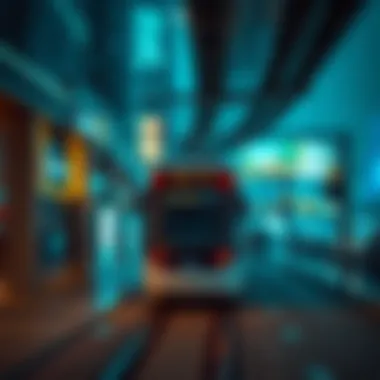
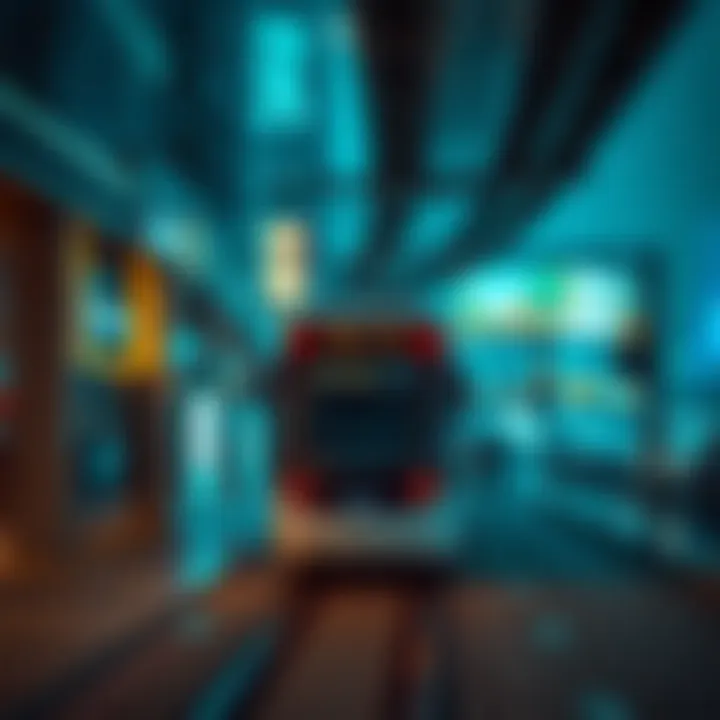
Design and Architecture
The design and architecture of tram stations in Dubai stand as a testament to innovation and cultural reflection. Each station is not simply a stop; it's an architectural statement that integrates seamlessly with the surrounding environment—balancing functionality and aesthetic appeal.
- Aesthetic Integration: Stations convey the essence of Emirati culture through the incorporation of local materials and design motifs. The use of glass and steel not only signifies modernity but also allows natural light to flood the interiors, creating a welcoming atmosphere. Structures like the Al Sufouh Tram Station have become landmarks in their own right, echoing Dubai's blend of tradition and modernity.
- User-Centric Design: Facilities are designed with a thorough understanding of user needs. This includes wide platforms to accommodate large crowds, easy access for mobility-impaired individuals, and sheltered waiting areas—ensuring comfort for all. What's more, visual signage is designed to be intuitive and accessible to both locals and tourists, minimizing confusion and enhancing the overall experience.
One significant aspect also involves the use of advanced building materials, which not only enhance durability but also lower maintenance costs over time. For instance, the use of energy-efficient systems in building design, allowing for lower energy consumption, speaks to the broader trends of sustainability.
Safety Features
Safety is paramount in the design of tram stations, reflecting not just a regulatory obligation, but a commitment to passenger welfare. The stations incorporate numerous safety features designed to safeguard commuters.
- Surveillance Systems: High-resolution CCTV cameras are installed throughout the stations, monitored in real-time to ensure quick responses to any potential incidents. This proactive approach promotes a sense of security among passengers, vital for encouraging tram usage.
- Emergency Protocols: Each tram station has clearly marked emergency exits and protocols displayed prominently, directing passengers on the necessary actions in case of an emergency. Regular training drills for staff ensure that all personnel are prepared to handle emergencies, providing an additional layer of reassurance for travelers.
- Passenger Safety Signals: Audible and visual alerts are crucial for conveying information regarding arriving trams or other critical announcements. This dual channel caters to diverse passenger needs, ensuring that everyone is informed at all times.
In short, the technical specifications of Dubai's tram stations encompass a wide range of considerations that lay the groundwork for effective and efficient public transport. Through innovative design and stringent safety measures, the tram system is aligned with a vision of sustainable, user-friendly transportation that meets the demands of a rapidly evolving urban environment.
Integration with Other Transport Modes
The integration of tram stations with other transport methods in Dubai is paramount in crafting an efficient urban transport landscape. A seamless interface between different mobility options not only enhances user experience but also promotes a holistic approach toward urban transportation. This interconnectedness ensures that commuters can easily navigate the city's sprawling layout, making travel more accessible and convenient for all.
Connecting to Metro Systems
Dubai's tram system isn't an island unto itself; rather, it harmoniously links up with the metro network. This is incredibly important when one considers the volume of traffic in the city. The tram stations are strategically positioned near metro stations, facilitating swift transfers between these two transport modes. Imagine disembarking from the metro after a long day at work and hopping onto a tram that whisks you away to your doorstep within minutes.
Such connectivity helps ease the burden on the roads, thereby reducing the likelihood of congestion. Trams like those at the Tram Station at Jumeirah Beach Residence are merely a stone's throw from the metro, allowing commuters to enjoy combined rides rather than relying on multiple vehicles.
This synergy promotes a lifestyle that’s not just about getting from point A to B. It’s an experience that cultivates independence for residents and visitors alike. Moreover, the user-friendly signages and intuitive layouts cater to both locals and tourists, ensuring that the transport experience is straightforward and pleasant.
Bus and Taxi Interfaces
In addition to metro connections, trams also play nicely with buses and taxis. Look around and you’ll notice bus stops strategically placed at tram stations; a small detail, yet one tremendously significant for improving urban mobility. This arrangement allows passengers to hop off the tram and practically step onto a waiting bus, streamlining their journey.
Taxis, too, have adapted to this model, with designated pick-up and drop-off zones located right outside many tram stations. This setup is not only convenient but also provides an additional safety layer, as taxis can be hailed in a well-lit, high-traffic area.
Each time someone can switch from tram to bus without hassle, it contributes to a greater ecosystem of public transport. As urban traffic continues to grow, such thoughtfulness in planning shines a light on the potential for other cities to adopt similar models.
"Integrated transport systems are pivotal in reducing travel times, enhancing commuter satisfaction, and minimizing urban congestion".
In summary, the integration with metro systems, buses, and taxis significantly amplifies the efficacy of Dubai's tram stations, fostering a holistic transport network that stands shoulder to shoulder with the rapidly evolving needs of the city.
User Experience at Tram Stations
User experience is pivotal in shaping the perceptions and use of public transport systems, and this holds true for tram stations in Dubai. An engaging user experience can mean the difference between a preference for trams versus other modes of transport. The design, features, and services offered at these stations contribute significantly to the overall satisfaction and comfort of passengers.
Accessibility Features
Accessibility ensures that every individual, regardless of physical capability, can effectively utilize the tram system. Dubai's tram stations have been developed with this in mind, showcasing several features aimed at enhancing inclusivity:
- Wheelchair Ramps: Trams are equipped with ramps that allow easy access for individuals using wheelchairs or with mobility constraints.
- Audio-Visual Aids: Information is presented through both audio announcements and visual displays, catering to those with hearing or vision impairments.
- Dedicated Areas: Stations have marked areas for individuals needing assistance or those who require additional time boarding the trams.
- Accessible Ticket Machines: These machines have user-friendly interfaces, and some even provide assistance options for those who may struggle to purchase tickets independently.
By prioritizing accessibility, the tram system in Dubai not only complies with regulatory requirements but significantly enhances the overall travel experience for diverse groups.
Customer Service Initiatives
Customer service is another critical component integral to providing a positive user experience at tram stations. Dubai has implemented various initiatives aimed at improving how passengers interact with the system:
- Information Desks: Stations often feature staffed information desks where passengers can inquire about routes, schedules, and ticketing information. This face-to-face interaction is vital for addressing any concerns that may arise.
- Multi-Lingual Staff: Given the multicultural makeup of Dubai, many stations employ staff who can converse in different languages. This makes it easier for expatriates and tourists to navigate the tram system.
- Online Support: A dedicated website along with social media platforms provide assistance and updates to commuters, ensuring that information is readily available.
- Feedback Channels: Dubai also encourages passenger feedback through surveys and apps. This initiative helps the authorities adapt and improve services based on user experiences and suggestions.
By combining accessibility with strong customer service initiatives, Dubai's tram stations stand as a testament to user-centric design, ensuring that commuting is as smooth and enjoyable as possible for everyone.
Ending
In summary, the user experience at tram stations in Dubai plays a critical role in the broader landscape of urban transportation. Accessibility features ensure that everyone can benefit from this service, while robust customer service initiatives reinforce positive interactions and continuous improvement. This focus on user experience ultimately contributes to the tram's integration into daily life, enhancing both satisfaction and usage among residents and visitors alike.
Environmental Impact of the Tram System
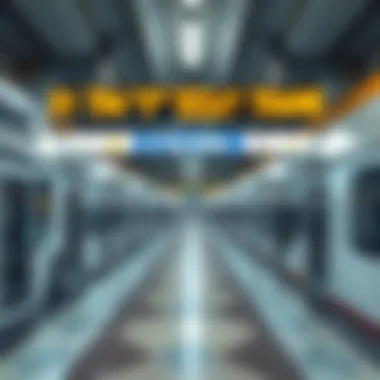

The tram system in Dubai stands as a beacon of modern urban transit, entwining itself with the city’s elaborate fabric. As the world increasingly grapples with environmental challenges, understanding the significance of the tram system's environmental impact becomes paramount. Not only does this system offer a sustainable mode of transport, but it also contributes positively to urban ecology, shaping a greener future for both residents and visitors.
Sustainability Practices
Dubai's tram system showcases multiple sustainability practices designed to lessen its environmental footprint. For starters, the tram stations feature solar panels that harness the abundant sunlight the region receives. This initiative isn’t just for show; it provides energy to power various stations, significantly decreasing reliance on conventional energy sources. Moreover, the tram vehicles themselves utilize energy-efficient technology, which means they consume less electricity than traditional forms of public transport.
The design and construction of tram stations also emphasize sustainability. Recycled materials are integrated into the building phases, reducing waste and promoting responsible manufacturing. Additionally, green spaces flank the tram stations, which serve as small ecosystems, improving air quality and enhancing the visual appeal of the urban surroundings. These practices illustrate a commitment not only to effective transportation but to ecological stewardship.
- Renewable Energy Utilization: Solar energy powers various station operations.
- Recycled Materials in Construction: Decreases waste generation.
- Enhanced Green Spaces: Improves urban air quality.
- Energy-Efficient Trams: Reduces overall energy consumption.
Reduction of Carbon Footprint
The reduction of the carbon footprint linked to Dubai's tram system cannot be overstated. By providing a reliable alternative to car travel, the tram effectively diminishes traffic congestion and lowers greenhouse gas emissions in the city. Each tram can carry a sizeable number of passengers, significantly reducing the number of vehicles on the road by encouraging public transport use.
Considering that a single tram can help take dozens of cars off the street, the impact on air quality and urban noise levels is profound. It translates into healthier urban living environments, which is beneficial for populations in high-density areas where air pollution is a growing concern. Moreover, by integrating with other modes of transport, as discussed in various sections of this article, the tram network enhances efficiency across the entire transportation landscape.
“Public transport can change urban living, fostering a sense of community while combating pollution.”
The tram system’s role in reducing the overall carbon footprint aligns with global efforts to combat climate change. By investing in such infrastructure, Dubai is not just enhancing its public transport network; it is actively participating in a larger, global pledge to create sustainable and eco-friendly urban development.
Ensuring that every aspect of the tram system contributes to a healthier environment is a step forward for the city and its inhabitants. As urban demands grow, adapting these newer technologies and methods becomes not just a necessity but a way to pave the future of urban mobility.
Economic Implications of the Tram Infrastructure
The existence of a tram system within a burgeoning metropolis like Dubai does not merely serve a transportational purpose; it carries far-reaching economic implications. As urban centers strive for sustainable growth, the role of tram systems becomes ever more crucial. Not only do they improve connectivity across various districts, but they also serve as a catalyst for economic vibrancy. Here, we delve into investment opportunities and their impact on local businesses, establishing how the tram infrastructure shapes the economic landscape of Dubai.
Investment Opportunities
Investment in tram infrastructure presents a wealth of opportunities for various stakeholders, including government bodies, private entities, and individual investors. The initial capital required to establish tram lines and stations might appear daunting; nevertheless, the long-term benefits justify the expenditure. As such, investors are increasingly drawn to projects that intertwine with the tram network. Moreover, with the city's ambition to expand its transport functionalities, the potential for return on investment is substantial.
- Real Estate Development: Many developers are looking to populate the space around tram stations with commercial and residential complexes. Properties that are situated close to tram stops often see an increase in demand, leading to higher rental yields and property values.
- Public-Private Partnerships (PPPs): The partnership between the government and private investors can be an effective means of funding tram-related projects. These collaborations can lead to lower costs and shared risks, creating an attractive proposition for investors.
- Technology Integration: With advancements in technology, many investors are exploring opportunities in smart transit solutions that can optimize tram operations. This includes the development of apps for real-time tracking, enhanced ticketing systems, and related technological innovations that enhance user experience.
Impact on Local Business
The ripple effect of tram stations on local businesses is evident in various capacities. Increased foot traffic in areas surrounding tram stations often translates into thriving small businesses, evolving the economic fabric of neighborhoods. Establishing an effective tram network not only fosters a commuting culture but also enhances the viability of businesses that depend on public access.
- Visibility and Accessibility: Businesses located near tram stops benefit from greater visibility and customer access. Cafés, shops, and other commercial entities witness an uptick in patronage due to the sheer volume of commuters passing by.
- Job Creation: As new businesses flourish, job opportunities tend to rise. This development stimulates the local economy, providing employment and increasing disposable income among residents, who in turn support local services.
- Ecosystem for Commerce: The tram system encourages development of a hub-and-spoke model, where businesses around tram stations can support each other. For instance, a tram stop might become a focal point for eateries, retail outlets, and services, enhancing the attractiveness of the area for new ventures.
"A strong tram network not only moves people but also cultivates communities and stimulates local economies beyond just transportation."
Real Estate Trends Linked to Tram Stations
The relationship between urban transport systems and real estate is as intertwined as roots of an ancient tree. In cities like Dubai, where innovation thrives, tram stations play a pivotal role in shaping the real estate landscape. This section delves into how proximity to tram lines influences property values and the emergence of new developments. Understanding these trends is crucial for investors, realtors, and anyone involved in the property market in Dubai.
Property Values Near Tram Lines
Properties located near tram stations see a noticeable uptick in value. This isn’t just conjecture; it’s rooted in demand. Convenience is king when it comes to real estate, and being within walking distance of a tram station offers accessibility that many homebuyers and renters prioritize.
Some key reasons why property values increase near tram stations include:
- Accessibility: Residents are more likely to use public transport, reducing the need for personal vehicles and the associated costs.
- Urban Design: Areas around tram stations often undergo enhancements, with pedestrian-friendly designs emerging, making them more attractive.
- Demand from Expatriates: Dubai's diverse population means a constant influx of expatriates seeking homes close to reliable transport, driving up demand and hence, prices.
As one local real estate agent remarked, "Being near transport links is like holding a golden ticket in this city. Buyers are willing to pay a premium for it."
New Developments in Proximity
The presence of tram stations catalyzes new developments. Developers often scout for land parcels within close proximity to tram lines, seeing them not just as transport facilities, but as opportunities for growth.
New residential complexes, commercial spaces, and mixed-use developments are cropping up around these stations. By investing in such properties, stakeholders can capitalize on rising trends. The following points illustrate this phenomenon further:
- Mixed-Use Developments: Many projects incorporate shops, offices, and residences, designed for a community that values a commuter lifestyle.
- Increased Activity: New establishments can invigorate an area, attracting foot traffic and business, thereby boosting property values further.
- Market Resilience: Properties in transit-oriented developments are often perceived as lower-risk investments due to their inherent demand tied to urban transport.
A notable example is the developments around the Jumeirah Tram Station, where new lofts and upscale eateries are increasingly common. These projects not only enhance the locality but set a trend that others are keen to follow.
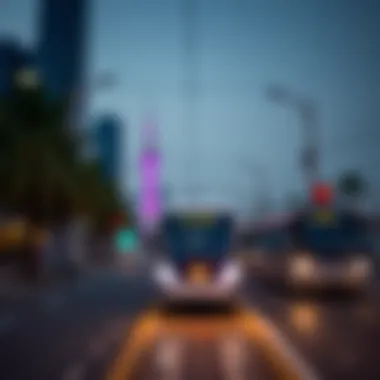
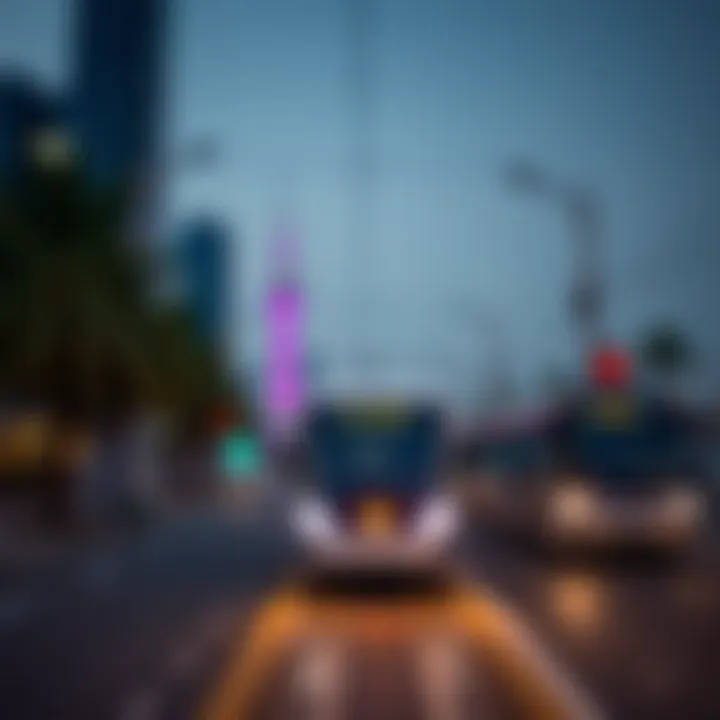
Connected to the growth in property values and development is an evolving mindset. Buyers and renters nowadays consider transportation convenience as essential as the size or condition of the property.
In summation, the dynamics between tram stations and real estate trends in Dubai present a fertile ground for investment and development. By keeping an eye on these areas, stakeholders can make strategic decisions that align with future growth patterns and urban mobility initiatives. The evolution of tram-linked neighborhoods might very well define the landscape of Dubai's real estate market in the years to come.
Challenges Faced by the Tram System
The tram system in Dubai, while an innovative and progressive mode of transportation, faces a range of challenges that impact its functionality and acceptance within the urban landscape. Understanding these challenges is crucial for stakeholders such as investors, realtors, homeowners, expatriates, and renters who are interested in the overall efficacy and potential expansion of this transport network.
With many commuters relying on public transport for their daily travel, resolving these obstacles can significantly enhance user experience, potentially leading to increased ridership and a better-integrated urban transport system.
Operational Issues
Operating a modern tram system like Dubai's requires meticulous planning and execution. Several operational issues need addressing to maintain a reliable and efficient service.
- Scheduling Conflicts: Managing the frequency and timing of trams can become a juggling act, especially during peak hours. A lack of trams during rush periods can lead to crowding and frustration among commuters.
- Maintenance Challenges: Like any mechanical system, trams require regular maintenance to ensure safety and reliability. Delays or issues in maintenance schedules can disrupt service, leading to dissatisfaction among users.
- Power Supply Reliability: Any interruption in power supply can halt operations entirely, causing a ripple effect on the transit system’s overall efficiency. Ensuring a stable and uninterrupted power source is essential for seamless tram operations.
- Infrastructure Limitations: The existing urban infrastructure, including tracks and station designs, may need upgrades to accommodate expanding tram lines or increased passenger volumes, which could require significant investment.
Addressing these issues is not merely about efficiency; it directly correlates with the user’s confidence in the tram system as a dependable means of public transportation.
Public Perception and Usage
Public perception is a double-edged sword. On one hand, a well-functioning tram service can enhance community sentiments towards public transport; on the other, negative perceptions can deter usage.
- Awareness of Services: Many residents may not fully understand the range of services offered, including tram routes and benefits. Improving information dissemination can foster increased ridership.
- Quality of Experience: Factors like cleanliness, safety, and comfort within the tram stations and on trams themselves weigh heavily on public opinions. If users feel safe and enjoy their travel, they are more likely to use the service regularly.
- Connection to Other Transport Modes: The convenience of connections to buses and metro can influence public perception. If changes in one mode disrupt the overall transit experience, it can lead to frustration and lower usage.
- Community Engagement: Public feedback is invaluable. Engaging with the community through surveys or forums can help authorities understand specific issues and perceptions that dictate tram usage.
In summary, mitigating these operational issues and addressing public perception challenges can enhance user satisfaction and establish the tram system as a preferred commuting choice in Dubai. A collaborative approach involving stakeholders in the planning and execution phases signifies a commitment to resolving issues steadily, contributing to the long-term success of this infrastructure.
Future Prospects for Dubai's Tram Network
The future of Dubai's tram system is as promising as it is pivotal in shaping urban mobility in a rapidly expanding metropolis. As the city continues to grow, the tram network stands as a beacon of modern transportation, not just for easing traffic but also for enhancing the urban landscape. The prospects of expansion and integration of new technologies within this system entail significant benefits, which can transform the commuting experience for residents and visitors alike.
Planned Expansions
In recent years, Dubai’s tram network has proven to be a vital asset in the transport infrastructure. Looking ahead, several planned expansions aim to increase its reach and efficiency:
- New Lines and Routes: Dubai authorities are considering new tram lines that would connect major residential areas to business districts. This increased accessibility can enhance the commuting experience for thousands.
- Increased Frequency: Increased frequency is on the table, aiming for trains to arrive every few minutes during peak times, thus reducing wait times significantly.
- Expanded Connectivity: Future plans focus on integrating tram lines with other forms of public transport, like the Metro and buses, creating a seamless travel experience across the city.
These expansions will not only lighten traffic on Dubai's roads but will also provide countless opportunities for local businesses, encouraging a more vibrant urban ecosystem.
Technological Innovations
Innovation is at the heart of the tram network’s future. Several technological advancements are being implemented to optimize operations and improve user experiences:
- Smart Ticketing Systems: Future fare collection systems are set to incorporate mobile apps and contactless payments, making it easier for commuters to navigate the transit options without hassle.
- Real-Time Tracking: New systems for real-time tracking will be introduced, allowing passengers to receive live updates on tram locations and estimated arrival times through their smartphones.
- Energy Efficiency Initiatives: There are plans to adopt more energy-efficient technologies, including solar panels and hybrid systems, to further reduce the environmental footprint of the trams.
"Technological advancements will enable Dubai's tram system not only to operate more effectively but also to adapt to the needs of a growing population."
Investing in these innovations will enhance the sustainability of the tram operation, ensuring that it remains an attractive transportation choice.
The fusion of planned expansions and technological innovations underscores a coherent strategy that positions Dubai's tram network as a leader in urban transportation. With these advancements, the network is not just a mode of transport; it serves as a catalyst for economic development and a model for sustainable transit solutions in the region. Engaged stakeholders, from investors to urban planners, should take note of these developments, as they carry substantial implications for the future of urban transport in Dubai.
Culmination
The conclusion of this article serves as a critical reflection on the multiple dimensions under which Dubai’s tram stations operate within the urban landscape. These tram stations are not mere stopping points; they are cornerstones of a more extensive transportation framework aimed at fostering connectivity and mobility throughout the emirate. As this examination has highlighted, the tram system significantly enhances the overall transport experience for residents and tourists alike.
Summary of Key Insights
Throughout this exploration, several paramount insights have emerged about the tram stations in Dubai:
- Developmental History: The evolution of the tram system traces back to a vision for interconnected public transport, which has matured into a comprehensive network that meets modern demands.
- Technological Integration: The incorporation of advanced technologies ensures that tram services remain punctual and reliable. Innovations like real-time tracking help users navigate the network seamlessly.
- Environmental Contributions: The tram system plays a pivotal role in decreasing urban congestion and carbon emissions, promoting a cleaner environment—something crucial for a city famed for its opulence.
- Economic Ramifications: Investing in tram infrastructure brings substantial returns, not just in terms of property values but also in local business growth driven by improved accessibility.
- Challenges: While achievements are notable, challenges like operational hurdles and public perception persist, requiring ongoing attention and adaptation.
"Trams represent more than transport; they are symbols of sustainable urban development that blend functionality with accessibility."
The Role of Trams in Urban Development
In the grand scheme, the role of tram systems in urban development cannot be overstated. They serve as vital arteries that connect various districts, enhancing the livability of the city. With an effective tram network, the potential for suburban expansions and urban rejuvenation increases significantly. People are drawn to areas with easy access to public transportation, boosting local economies and enhancing residential satisfaction.
Here are some specific considerations about the impact of trams on urban development:
- Increased Property Demand: Locations near tram stations often see a surge in property demand due to access convenience, directly correlating higher values with strategic transport nodes.
- Boost to Local Businesses: Shops and restaurants flourish in areas with heavy tram traffic, leading to a vibrant local economy. Business owners can expect foot and vehicular traffic to generate sales and build community ties.
- Promoting Green Spaces: The tram network facilitates the development of pedestrian-friendly areas where citizens can unwind, thus integrating leisure spaces into the urban tapestry, harmonizing nature with habitation.
In summation, Dubai’s tram stations signify not only transportation advancements but also a commitment to progressive urban planning, sustainability, and economic vitality. Understanding their importance fosters a broader appreciation of how public infrastructure can enhance urban life, serving as a model for other burgeoning cities.



